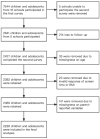Association between Types of Screen Time and Weight Status during the COVID-19 Pandemic: A Longitudinal Study in Children and Adolescents
- PMID: 37432199
- PMCID: PMC10181058
- DOI: 10.3390/nu15092055
Association between Types of Screen Time and Weight Status during the COVID-19 Pandemic: A Longitudinal Study in Children and Adolescents
Abstract
Background: This study aimed to investigate the changes in distinct types of screen time and explore their longitudinal association with children and adolescents' weight status.
Methods: A two-wave longitudinal study was conducted among 2228 children and adolescents (6-19 years) in Shanghai, China, before and during the pandemic. Recreational screen time (watching TV/videos, online gaming, using social media, and browsing webpages), educational screen time (online homework and online class), and BMI were measured using a self-reported questionnaire. Mixed-effects models were constructed to assess the associations between screen time and weight status.
Results: The prevalence of overweight and obesity was 20.5% and 10.2% at baseline, respectively. Both recreational and educational screen time increased significantly over two months. While recreational screen time was found to be a risk factor for obesity, it was not the case for educational screen use. Specifically, adolescents who spent more time watching TV/videos had a higher obesity risk (OR = 1.576). No significant associations were found in children.
Conclusions: Overweight and obesity were prevalent among children and adolescents in China. Reducing screen-based activities is a promising strategy to prevent unhealthy weight gain in Chinese children and adolescents, while it is necessary to consider the content and distinguish between educational and recreational screen use.
Keywords: children and adolescents; obesity; screen time.
Conflict of interest statement
The authors declare no conflict of interest.
Figures
Similar articles
-
Influence of eating while watching TV on food preference and overweight/obesity among adolescents in China: a longitudinal study.Front Public Health. 2024 Sep 17;12:1423383. doi: 10.3389/fpubh.2024.1423383. eCollection 2024. Front Public Health. 2024. PMID: 39354995 Free PMC article.
-
The association between screen time and reported depressive symptoms among adolescents in Sweden.Fam Pract. 2021 Nov 24;38(6):773-779. doi: 10.1093/fampra/cmab029. Fam Pract. 2021. PMID: 34160045
-
Association of Changes of lifestyle behaviors before and during the COVID-19 pandemic with mental health: a longitudinal study in children and adolescents.Int J Behav Nutr Phys Act. 2022 Jul 26;19(1):92. doi: 10.1186/s12966-022-01327-8. Int J Behav Nutr Phys Act. 2022. PMID: 35883177 Free PMC article.
-
Assessment of Changes in Child and Adolescent Screen Time During the COVID-19 Pandemic: A Systematic Review and Meta-analysis.JAMA Pediatr. 2022 Dec 1;176(12):1188-1198. doi: 10.1001/jamapediatrics.2022.4116. JAMA Pediatr. 2022. PMID: 36342702 Free PMC article.
-
COVID-19 and screen-based sedentary behaviour: Systematic review of digital screen time and metabolic syndrome in adolescents.PLoS One. 2022 Mar 21;17(3):e0265560. doi: 10.1371/journal.pone.0265560. eCollection 2022. PLoS One. 2022. PMID: 35312701 Free PMC article.
Cited by
-
Screen media activity in youth: A critical review of mental health and neuroscience findings.J Mood Anxiety Disord. 2023 Oct;3:100018. doi: 10.1016/j.xjmad.2023.100018. Epub 2023 Aug 11. J Mood Anxiety Disord. 2023. PMID: 37927536 Free PMC article.
-
FTO and NOS3 genes associated with pediatric obesity: Corações de Ouro Preto study.BMC Pediatr. 2025 Mar 20;25(1):223. doi: 10.1186/s12887-025-05570-3. BMC Pediatr. 2025. PMID: 40114142 Free PMC article.
-
Associations of Academic Study- and Non-Study-Related Sedentary Behaviors with Incident Obesity in Children and Adolescents.Nutrients. 2025 May 9;17(10):1633. doi: 10.3390/nu17101633. Nutrients. 2025. PMID: 40431373 Free PMC article.
-
Knowledge, Attitude and Practices of Parents Towards Obesity in Children in Aseer Region, Southern of Saudi Arabia.Int J Gen Med. 2025 Aug 12;18:4391-4401. doi: 10.2147/IJGM.S520120. eCollection 2025. Int J Gen Med. 2025. PMID: 40831605 Free PMC article.
-
Comparison of central precocious puberty frequency before and during COVID-19: a systematic review and meta-analysis.BMC Endocr Disord. 2024 Oct 17;24(1):219. doi: 10.1186/s12902-024-01749-4. BMC Endocr Disord. 2024. PMID: 39420314 Free PMC article.
References
-
- NCD Risk Factor Collaboration Worldwide trends in body-mass index, underweight, overweight, and obesity from 1975 to 2016: A pooled analysis of 2416 population-based measurement studies in 128·9 million children, adolescents, and adults. Lancet. 2017;390:2627–2642. doi: 10.1016/S0140-6736(17)32129-3. - DOI - PMC - PubMed
-
- Dong Y., Jan C., Ma Y., Dong B., Zou Z., Yang Y., Xu R., Song Y., Ma J., Sawyer S.M. Economic development and the nutritional status of Chinese school-aged children and adolescents from 1995 to 2014: An analysis of five successive national surveys. Lancet Diabetes Endocrinol. 2019;7:288–299. doi: 10.1016/S2213-8587(19)30075-0. - DOI - PubMed
-
- Daniels S.R., Arnett D.K., Eckel R.H., Gidding S.S., Hayman L.L., Kumanyika S., Robinson T.N., Scott B.J., St Jeor S., Williams C.L. Overweight in children and adolescents: Pathophysiology, consequences, prevention, and treatment. Circulation. 2005;111:1999–2012. doi: 10.1161/01.CIR.0000161369.71722.10. - DOI - PubMed
MeSH terms
Grants and funding
- 71804110/National Natural Science Foundation of China
- 21QA1405300/Shanghai Science and Technology Development Funds
- 22YJAZH116/Science Foundation of Ministry of Education of China
- 20X100040012/Science Foundation for new teachers of Shanghai Jiao Tong University School of Medicine
- GW-10.1-XK07/Shanghai Municipal Health Commission
LinkOut - more resources
Full Text Sources
Medical



